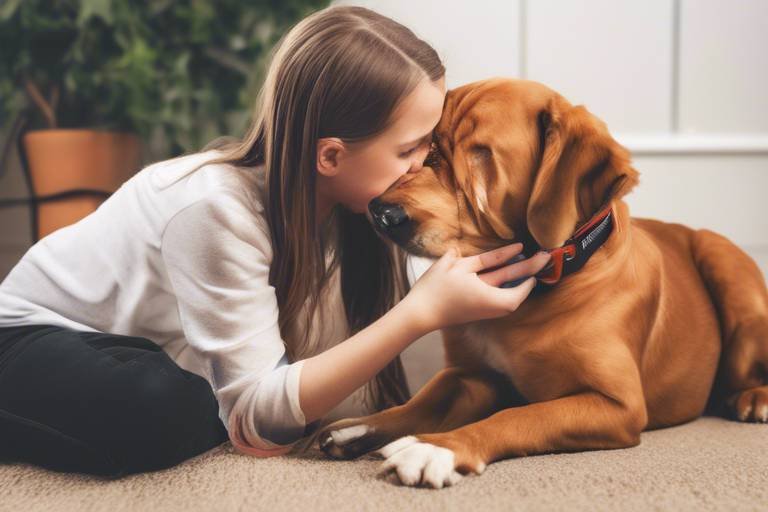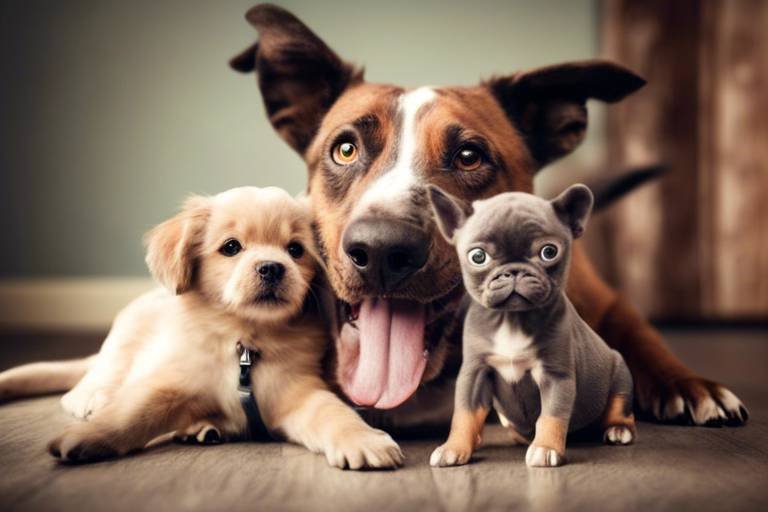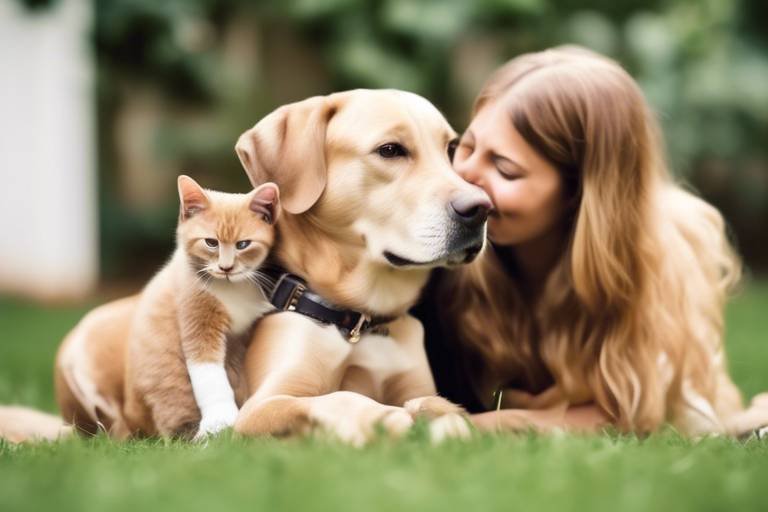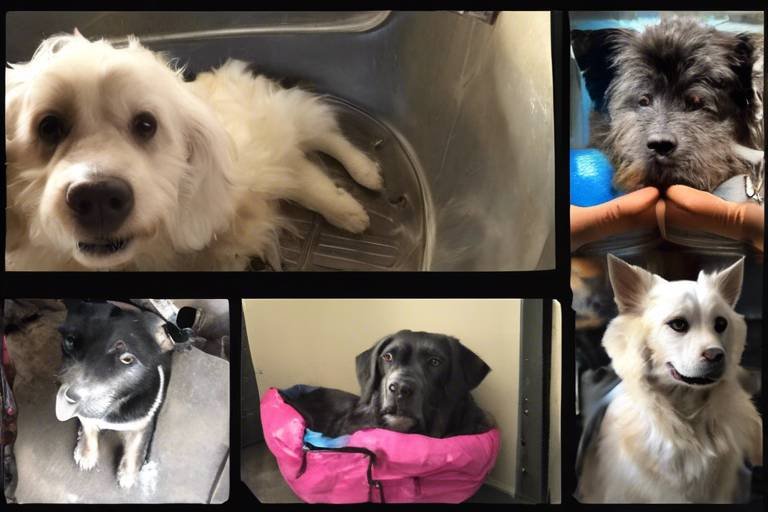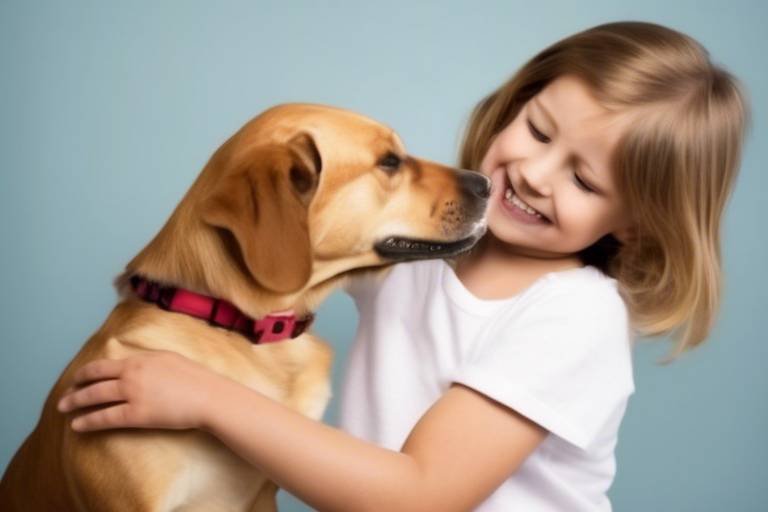How to Understand Your Rescue Pet’s Body Language
Bringing a rescue pet into your home can be one of the most rewarding experiences of your life, but it can also come with its challenges. Understanding your new furry friend’s body language is essential for building a strong bond and ensuring they feel safe and secure. Just like humans, pets communicate their feelings and emotions through their body language. By learning to interpret these signals, you can better respond to their needs, creating a harmonious living environment. So, let’s dive into the fascinating world of pet body language and discover how to decode those adorable yet sometimes puzzling signals!
Understanding fundamental body language signals is crucial for interpreting your rescue pet's emotions. For instance, a wagging tail might seem like a universal sign of happiness, but did you know that the context can change its meaning? Here are some common signs to look out for:
- Happiness: Look for relaxed bodies, wagging tails, and playful behaviors.
- Fear: Signs like cowering, hiding, or a tucked tail indicate your pet may be scared.
- Aggression: Raised hackles, growling, or a stiff body posture can signal that your pet feels threatened.
By recognizing these basic signals, you can respond appropriately and help your rescue pet feel more at ease in their new surroundings.
A pet's tail position can reveal a lot about its mood. For example, a high, wagging tail usually indicates excitement or happiness, while a low or tucked tail often signals fear or submission. Understanding these tail positions can help you gauge your pet's emotional state and respond accordingly.
Tail wagging is often associated with joy, but the context matters. A wagging tail can mean different things based on the speed and height of the wag. For instance, a fast wagging tail might indicate excitement, while a slow wag can suggest a more relaxed state. It's crucial to observe the entire body language of your pet to get a complete understanding of their feelings.
The speed of a wag can change its meaning significantly. A fast, high wag usually indicates that your pet is feeling playful and energetic, while a slow wag might mean they are feeling unsure or cautious. By paying attention to these nuances, you can better interpret your pet’s emotional state and respond appropriately.
A tucked tail often signals fear or submission. If you notice your pet's tail is tucked between their legs, it's a clear indication that they may be feeling threatened or anxious. In such cases, it's essential to provide comfort and reassurance. Try speaking softly to your pet and offering them a safe space where they can relax and feel secure.
A pet's posture can tell you much about its confidence and comfort level. For example, a relaxed body posture with a loose stance indicates that your pet is comfortable and happy, while a tense body with raised hackles might suggest fear or aggression. Observing these postures can help you understand what your pet is feeling and how you can best support them.
Just like humans, pets express emotions through their faces. A soft gaze, relaxed mouth, and ears in a neutral position usually indicate a calm and happy pet, while wide eyes, a tense mouth, or ears pinned back may signal fear or aggression. Paying attention to these facial expressions can give you deeper insights into your pet's emotional state.
The eyes can reveal a lot about your pet's feelings. For instance, dilated pupils can indicate excitement or fear, while soft, relaxed eyes typically suggest contentment. By learning to interpret different eye shapes and movements, you can gain a better understanding of your pet's emotional state.
Alongside eyes, mouth and ear positions can also indicate emotions. A relaxed mouth and ears held in a neutral position often suggest a calm pet, while a closed mouth with ears pinned back can indicate fear or aggression. By analyzing these features, you can gain valuable insights into your pet’s mood and feelings.
Understanding body language is just the first step; knowing how to respond is equally important. When your pet shows signs of happiness, engage with them through play or affection. If they display fear or anxiety, provide a calm environment and reassure them with your voice and presence. Here are some tips on how to react appropriately:
- Stay calm and composed; your pet can sense your emotions.
- Use positive reinforcement to encourage desired behaviors.
- Give your pet space if they seem overwhelmed.
By responding to your pet's signals, you can foster a deeper bond and create a more harmonious relationship.
Q: How can I tell if my pet is happy?
A: Look for signs like a wagging tail, relaxed body posture, and playful behavior.
Q: What should I do if my pet shows signs of fear?
A: Provide comfort and reassurance, and create a safe space for your pet to relax.
Q: How can I improve my understanding of my pet's body language?
A: Spend time observing your pet in different situations and pay attention to their reactions.

Recognizing Basic Body Language Signals
Understanding your rescue pet's body language is like unlocking a secret language that allows you to connect with them on a deeper level. Just as we express our feelings through facial expressions and gestures, pets communicate their emotions through a variety of signals. By recognizing these basic body language signals, you can better interpret your furry friend's mood and respond appropriately, fostering a stronger bond.
One of the most common signs of happiness in pets is a relaxed body posture. When your pet is comfortable, you'll notice their body is loose, and they may even roll over to expose their belly—a clear invitation for some belly rubs! On the flip side, if your pet's body is tense, ears are back, and they seem to be avoiding eye contact, it could indicate fear or anxiety. It's essential to be observant and responsive to these signals, as they can help you create a safe environment for your pet.
In addition to posture, vocalizations also play a role in body language. For instance, a soft whine or gentle purring might signal contentment, while barking or growling could indicate discomfort or aggression. Understanding the context of these sounds is crucial. For example, if your dog barks excitedly when you come home, it’s likely a sign of joy rather than aggression.
Moreover, the position of your pet's ears can provide valuable insights into their emotional state. Ears that are perked up and facing forward usually indicate curiosity or alertness, while ears that are flattened against the head can signify fear or submission. Remember, the key is to look for a combination of signals rather than relying on a single indicator. For instance, if your cat is hiding but has its ears perked, it might be curious yet cautious about its surroundings.
To help you better understand these signals, here’s a quick overview of some basic body language indicators:
| Emotion | Body Language Signals |
|---|---|
| Happiness | Relaxed posture, wagging tail, playful behavior |
| Fear | Tucked tail, flattened ears, avoidance behavior |
| Aggression | Stiff body, raised hackles, growling or barking |
By being attentive to these signals, you can respond more effectively to your pet's needs. For example, if you notice your dog has a tucked tail and is backing away, it’s crucial to give them space and not force interaction. Instead, create a calm environment and allow them to approach you when they feel safe.
In conclusion, recognizing basic body language signals is vital for understanding your rescue pet's emotions. By observing their posture, vocalizations, and ear positions, you can gain valuable insights into how they are feeling. This knowledge not only enhances your relationship but also ensures that your pet feels secure and understood in their new home.
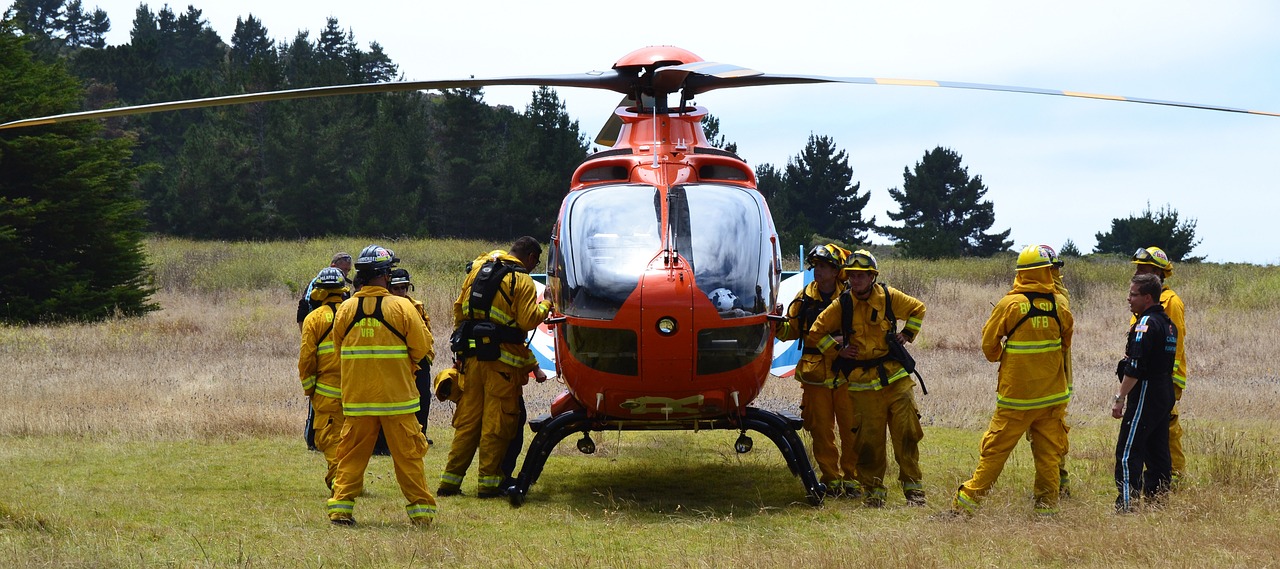
The Importance of Tail Position
The position of your pet's tail is a vital indicator of its emotional state. Just like a painter uses colors to express feelings on a canvas, your furry friend uses its tail to communicate a spectrum of emotions. Understanding these signals can significantly enhance your bond with your rescue pet, providing insights into their comfort levels and emotional needs. For instance, a tail held high can indicate confidence and happiness, while a tail that is low or tucked can signal anxiety or fear. In essence, your pet’s tail acts as a mood ring, revealing how they truly feel in their new environment.
When observing your pet's tail, consider the context in which the tail movements occur. For example, if your dog wags its tail while playing, it’s likely feeling joyful. However, if the tail is wagging but the body is tense, it may indicate a mix of excitement and anxiety. This duality of emotions can be puzzling, but with careful observation, you can learn to decode these signals effectively.
Here’s a quick overview of different tail positions and what they might signify:
| Tail Position | Potential Emotion |
|---|---|
| High and Wagging | Excitement or Happiness |
| Neutral Position | Relaxed |
| Low or Tucked | Fear or Submission |
| Slow Wagging | Unsure or Cautious |
It's essential to remember that each pet is unique, and their tail language may vary. Observing your pet in different scenarios will help you understand their specific cues. For instance, a dog might wag its tail vigorously when greeting you after a long day, but if it’s in a new environment, the same wag might be slower and more tentative. This nuanced understanding can help you create a safe space for your pet, allowing them to express themselves freely.
Moreover, paying attention to tail position can also help you identify when your pet might be feeling overwhelmed. If you notice your dog’s tail drooping or tucked between its legs, it’s a clear sign that they might need some reassurance. This is where your role as a loving owner comes into play; offering comfort and a calm presence can make all the difference in helping your pet feel secure.
In summary, the tail is not just an appendage; it’s a powerful tool for communication. By tuning into the subtleties of your pet’s tail position, you can foster a deeper connection and create a nurturing environment where your rescue pet feels safe, understood, and loved.
- What does it mean if my dog's tail is wagging but they seem tense?
This can indicate mixed emotions; your dog may be excited yet anxious. It's essential to assess the overall body language to understand their feelings better.
- How can I help my pet feel more comfortable if their tail is tucked?
Provide a calm environment, avoid overwhelming situations, and offer gentle reassurance to help your pet feel safe.
- Do all pets communicate the same way with their tails?
No, different species and even individual pets may have their unique ways of expressing emotions through their tails.
Tail Wagging: A Sign of Happiness
When you see your furry friend wagging its tail, it’s hard not to smile, right? Tail wagging is often the first sign that your pet is feeling happy and excited. However, it's crucial to understand that not all tail wags are created equal. Just like a smile can mean different things depending on the context, so can a wagging tail. For instance, a slow, gentle wag might indicate that your pet is feeling relaxed and content, while a fast, frantic wag could mean they are overly excited or even a bit anxious.
To help you decode this delightful behavior, let's break down the different types of tail wags and what they mean:
- Fast Wagging: This is often a sign of pure joy. If your pet is wagging its tail rapidly, especially when they see you, they are likely expressing their excitement and happiness. Think of it as their way of saying, "I’m so glad to see you!"
- Slow Wagging: A slow wag can indicate that your pet is feeling calm and relaxed. This might happen when they are lounging around or enjoying some gentle petting. It’s a comforting signal that they feel safe in their environment.
- Side-to-Side Wagging: If your pet’s tail is wagging wide and sweeping from side to side, it usually means they are very happy and welcoming. It’s like a furry version of a warm hug!
- High Tail Position: When your pet holds its tail high while wagging, it’s a sign of confidence and excitement. They are ready to play and engage with you!
- Low or Tucked Tail: If the tail is wagging but held low or tucked between the legs, it can indicate a mix of emotions, possibly a sign of submission or uncertainty. In this case, it’s essential to approach your pet gently and reassure them.
Understanding these nuances can significantly enhance your interaction with your rescue pet. By paying attention to their tail wagging, you can better gauge their emotional state and respond appropriately. This not only strengthens your bond but also helps your pet feel more secure in their new home. Remember, every wag tells a story, so take the time to listen!
Q: Can a wagging tail mean my pet is aggressive?
A: Yes, sometimes a wagging tail can indicate aggression, especially if it is held high and stiff. It’s essential to observe the overall body language and context.
Q: What should I do if my pet's tail is wagging but they seem scared?
A: If your pet is wagging their tail but appears fearful, it’s important to create a safe space for them. Speak in a calm voice and give them time to relax.
Q: How can I encourage my pet to express happiness?
A: Engaging in playtime, offering treats, and providing affection can help your pet feel happy and secure, leading to more tail wagging!
Fast vs. Slow Wagging
When it comes to understanding your rescue pet's tail wagging, speed is everything. A fast wag can be an exhilarating sight, often signaling excitement or joy. Picture this: your pet sees you after a long day, and that tail is whipping back and forth like a flag in a strong wind. This is a clear indication that your furry friend is thrilled to see you! However, it’s essential to consider the context because a rapid wag can also indicate overstimulation. If your pet is wagging vigorously while surrounded by too many people or noises, it might be a sign of anxiety rather than pure happiness.
On the flip side, a slow wag can tell a different story. Imagine your pet standing still, tail moving gently from side to side. This can indicate a more relaxed state, where your pet is feeling comfortable and at ease. It's like when you are lounging on a Sunday afternoon, enjoying a book—there's a sense of calmness. However, if the slow wag is accompanied by other signs of uncertainty, such as a lowered head or avoidance of eye contact, it may indicate that your pet is feeling unsure or hesitant about something in their environment.
To make it easier to remember, here’s a quick breakdown of what fast and slow wagging can mean:
| Wag Speed | Possible Emotion | Contextual Clue |
|---|---|---|
| Fast Wagging | Excitement or Overstimulation | Check surroundings for stressors |
| Slow Wagging | Relaxation or Uncertainty | Observe other body language signals |
In summary, paying attention to the speed of your pet's tail wagging is crucial for understanding their emotional state. Fast wagging generally indicates happiness but can also signal anxiety in certain situations, while slow wagging often reflects a calm demeanor, yet can also hint at uncertainty. By observing these subtle differences, you can better respond to your rescue pet's needs, ensuring they feel safe and secure in their new home.
- What does it mean if my dog wags their tail in a circle? - This often indicates extreme excitement and happiness, as if they are trying to show you just how thrilled they are!
- Can a cat wag its tail like a dog? - Yes, but it usually means something different. Cats often wag their tails when they are annoyed or agitated.
- How can I tell if my pet is happy? - Look for signs like wagging tails, relaxed body posture, and playful behavior.
- What should I do if my pet shows signs of fear? - Approach them calmly, give them space, and avoid overwhelming them. Create a safe environment where they can retreat if needed.
Tail Tucked: Understanding Fear
When you see your rescue pet with its tail tucked between its legs, it’s more than just a cute quirk; it’s a clear signal of fear or submission. This posture is a natural instinct for many animals, serving as a protective mechanism. Think about it: when a pet feels threatened, tucking the tail is akin to saying, “I don’t want any trouble!” It’s their way of showing they are feeling vulnerable and are not ready to confront whatever is causing their distress.
Recognizing this body language is essential for you as a pet owner. It’s a cry for help, a silent plea for reassurance. If you notice your pet exhibiting this behavior, it’s important to assess the situation. Are there loud noises around? Are there unfamiliar faces or pets nearby? Identifying the trigger can help you create a more comfortable environment for your furry friend. Here are a few signs to look for when a pet's tail is tucked:
- Body Language: Apart from the tail position, you might notice other signs like flattened ears, wide eyes, or a lowered body posture.
- Vocalizations: Whining or whimpering can accompany a tucked tail, indicating distress.
- Behavior: Your pet may try to hide or seek out a safe space, indicating they feel threatened.
Understanding the context is crucial. For instance, if your pet is in a new environment, it may take time for them to adjust. In such cases, patience is key. You can help them feel more secure by creating a safe space where they can retreat when feeling anxious. This could be a cozy bed in a quiet corner or a designated area where they can observe their surroundings without feeling overwhelmed.
Moreover, positive reinforcement can work wonders. When your pet shows signs of bravery—like exploring their new environment or approaching you—reward them with treats or affection. This not only boosts their confidence but also strengthens the bond between you and your pet.
In summary, a tucked tail is a significant indicator of fear or submission in rescue pets. By being attentive to this and other accompanying signals, you can better understand your furry companion's emotional state and provide the comfort they need to thrive in their new home.
- What should I do if my pet has a tucked tail? - If you notice your pet has a tucked tail, try to identify the trigger and create a calm environment. Offer reassurance and allow them space to feel safe.
- Can a tucked tail indicate something other than fear? - Yes, while it often signals fear, a tucked tail can also indicate submission, especially in social situations with other animals.
- How long does it take for a rescue pet to adjust? - Every pet is different; some may adjust within days, while others may take weeks or even months. Patience and understanding are crucial.
Body Posture: A Window to Emotions
When it comes to understanding your rescue pet, body posture is one of the most revealing aspects of their emotional state. Just like humans, pets communicate a lot through their body language, and their posture can tell you whether they feel confident, anxious, or even threatened. Imagine walking into a room and instantly sensing the mood based on how people are standing or sitting—your pet does the same thing! By observing their posture, you can gain valuable insights into how they are feeling and what they might need from you.
For instance, a pet that stands tall with its head held high and ears perked up is likely feeling confident and curious. This is a great sign that they are comfortable in their environment and ready to explore. On the other hand, if your pet is crouching low to the ground, with its tail tucked between its legs and ears pulled back, it may indicate feelings of fear or submission. Think of it like a person who is trying to make themselves smaller in a crowded room; they are likely feeling overwhelmed or threatened.
Another important aspect of body posture is the way your pet positions its legs. A pet that stands with its legs slightly apart and weight distributed evenly is generally feeling secure. In contrast, if they are standing with their legs close together or shuffling nervously, it could be a sign that they are feeling unsure or anxious. This is crucial information that can help you create a more comfortable environment for your furry friend.
To help you interpret your pet's body posture more effectively, here are some common postures and their meanings:
- Relaxed Posture: Ears up, tail wagging gently, standing or lying comfortably.
- Fearful Posture: Tail tucked, ears back, crouched low to the ground.
- Aggressive Posture: Stiff body, raised hackles, direct stare, and ears forward.
- Submissive Posture: Lowered head, body crouched, and tail tucked.
By paying attention to these signals, you can respond to your pet's needs more effectively. For example, if you notice your pet exhibiting a fearful posture, you can take steps to create a more secure environment by providing a safe space or engaging in gentle play to help them feel at ease. Remember, the more you understand your pet's body language, the stronger your bond will become, paving the way for a happier, healthier relationship.
1. How can I tell if my pet is happy?
Most pets show happiness through relaxed body posture, wagging tails, and playful behavior. Look for signs like a relaxed face and a willingness to engage with you.
2. What should I do if my pet shows signs of fear?
If your pet is showing fear, it’s essential to create a safe space for them. Use calming techniques like soft voices, gentle petting, and providing a cozy spot where they can retreat.
3. Can body language differ between different species?
Absolutely! While many body language cues are similar across species, each animal has its unique signals. It’s essential to learn the specific signs for your pet's species and breed.
4. How can I improve my pet's confidence?
Building your pet's confidence can be achieved through positive reinforcement training, socialization with other pets, and providing them with a stable routine.

Facial Expressions in Pets
Just like humans, pets have a unique way of expressing their emotions through their faces. Understanding these facial expressions is a vital part of building a strong bond with your rescue pet. When you look closely, you’ll notice that every little wrinkle, twitch, or gaze can tell a story about how your furry friend is feeling. For instance, a relaxed face often indicates comfort and happiness, while a tense or scrunched expression can signal stress or discomfort. By learning to read these expressions, you can better respond to your pet's needs and create a more harmonious environment.
One of the most significant aspects of facial expressions in pets is their eyes. The phrase "the eyes are the window to the soul" holds true for our four-legged companions as well. A pet's gaze can convey a range of emotions from love and trust to fear and anxiety. For example, if your dog approaches you with soft, relaxed eyes, it typically means they feel safe and affectionate. Conversely, if their eyes are wide and darting, it might indicate fear or uncertainty. Understanding these nuances can help you provide the right support when your pet is feeling overwhelmed.
Another critical component of your pet's facial expression is their mouth. A relaxed, slightly open mouth often signifies a calm and happy pet, while a tightly closed mouth may indicate tension or discomfort. Additionally, a dog that shows its teeth might not always be aggressive; it could also be a sign of playfulness or excitement, depending on the context. Observing these changes can help you navigate your pet's emotional landscape more effectively.
Moreover, the position of a pet's ears plays a significant role in understanding their feelings. Ears that are perked up and facing forward usually indicate curiosity or excitement, while ears that are flattened against the head can signal fear or submission. For instance, if your cat approaches you with ears back and eyes wide, it’s a clear sign that they are feeling threatened. Recognizing these signals can help you create a safe space for your pet, allowing them to feel more at ease in their new home.
In summary, being attuned to your rescue pet's facial expressions can enhance your relationship and help you respond to their emotional needs. By observing their eyes, mouth, and ears, you can gain valuable insights into how they are feeling. Remember, every pet is unique, and it may take time to learn the specific cues that your furry friend exhibits. Patience and attentiveness will go a long way in ensuring your pet feels understood and loved.
- How can I tell if my pet is happy? Look for relaxed body posture, a wagging tail, and soft eyes. A happy pet often has a playful demeanor and seeks interaction.
- What should I do if my pet shows signs of fear? Give them space and time to calm down. Speak softly and avoid sudden movements to help them feel safe.
- Can pets express emotions like humans? Yes, pets can express a wide range of emotions, including joy, fear, and anxiety, often through body language and facial expressions.
Eyes: The Window to the Soul
When it comes to understanding our rescue pets, their eyes can be incredibly revealing. Just like humans, pets express a multitude of emotions through their eyes, making them a vital part of their body language. Have you ever looked into your pet's eyes and felt an instant connection? That’s because their eyes can communicate feelings of happiness, fear, trust, and even anxiety. For instance, a relaxed pet may have soft, wide-open eyes, while a frightened one might have dilated pupils and a tense gaze. Paying attention to these subtle cues can help you respond appropriately to your furry friend’s emotional state.
To help you decode what your pet's eyes are telling you, here are some key indicators to look out for:
- Soft Eyes: When your pet looks at you with relaxed eyelids and a gentle gaze, it usually means they feel safe and content. This is a great sign that your pet trusts you.
- Staring: If your pet is staring intensely, it could indicate curiosity or a desire to assert dominance. However, prolonged staring can also be a sign of aggression, so it's essential to observe the context.
- Squinting: A pet that squints may be feeling threatened or uncomfortable. Alternatively, they might be trying to shield their eyes from bright light. Always consider the environment when interpreting this behavior.
- Dilated Pupils: When your pet’s pupils are dilated, it can be a sign of excitement or fear. This is especially true in situations where they might feel threatened or overly stimulated.
Understanding these eye signals can significantly enhance your bond with your pet. For example, if you notice your pet exhibiting dilated pupils and a tense posture, it might be time to give them some space or comfort them, depending on the situation. Conversely, if their eyes are relaxed and soft, it’s a perfect opportunity to engage in play or cuddle time. Remember, your pet’s eyes are not just tools for seeing; they are windows into their emotional world.
In conclusion, taking the time to observe your rescue pet's eyes can lead to a deeper understanding of their feelings and needs. By recognizing these signals, you can create a more harmonious environment that nurtures trust and affection. So next time you gaze into those soulful eyes, remember that you are not just looking; you are communicating on a level that transcends words.
- How can I tell if my pet is happy? Look for relaxed body language, soft eyes, and a wagging tail. Happy pets often seek interaction and play.
- What should I do if my pet shows signs of fear? Approach your pet gently, speak softly, and provide a safe space for them to retreat. Avoid forcing interaction until they feel comfortable.
- Can pets express emotions like humans? Yes! Pets have a range of emotions and can express them through body language, vocalizations, and facial expressions.
Mouth and Ears: Additional Indicators
When it comes to understanding your rescue pet's emotions, the mouth and ears are like the *cherry on top* of the body language cake. Just as we express our feelings through smiles or frowns, pets have their own unique ways of communicating how they feel through these features. For instance, a dog’s mouth can tell you whether it’s feeling relaxed or anxious. A slightly open mouth with a relaxed tongue hanging out usually indicates a happy and content pup, while a tightly closed mouth might signal stress or discomfort. So, the next time your furry friend greets you, take a moment to observe their mouth – it could reveal a lot about their mood!
Similarly, the position of your pet's ears can provide crucial insights into their emotional state. Ears that are perked up and facing forward often indicate curiosity or excitement, as if they are saying, “What’s going on? I want to be part of it!” On the other hand, ears that are pinned back against the head can signify fear or submission, suggesting that your pet might be feeling threatened or unsure of their surroundings. It’s fascinating how these small details can paint a bigger picture of your pet’s emotional landscape!
To make it even clearer, let’s break down some common mouth and ear positions and what they typically indicate:
| Indicator | Meaning |
|---|---|
| Open Mouth, Relaxed Tongue | Happy and Content |
| Tightly Closed Mouth | Stress or Discomfort |
| Perked Ears | Curiosity or Excitement |
| Pinned Back Ears | Fear or Submission |
Understanding these signals can significantly enhance your relationship with your rescue pet. By paying attention to their mouth and ear positions, you can respond more effectively to their needs and emotions. For example, if you notice your pet’s ears pinned back and their mouth closed, it might be a good idea to give them some space or comfort them with gentle words and a soft touch. On the flip side, if their mouth is relaxed and their ears are perked, it’s a great opportunity to engage them in play or affection!
In conclusion, the mouth and ears are crucial components of your pet’s body language. By being observant and interpreting these signals correctly, you can create a more harmonious and understanding environment for your furry friend. It’s all about building that bond of trust and communication, which is essential for a happy life together!
- How can I tell if my pet is happy? Look for a relaxed body posture, wagging tail, and an open mouth with a relaxed tongue.
- What does it mean if my pet’s ears are pinned back? This usually indicates fear or submission, so it’s important to reassure your pet.
- Can I train my pet to express emotions differently? While you can’t change their natural instincts, training can help them feel more secure and confident, which may alter their body language over time.
- Why is understanding body language important? Understanding body language helps you respond appropriately to your pet’s needs, fostering a stronger bond and ensuring their well-being.
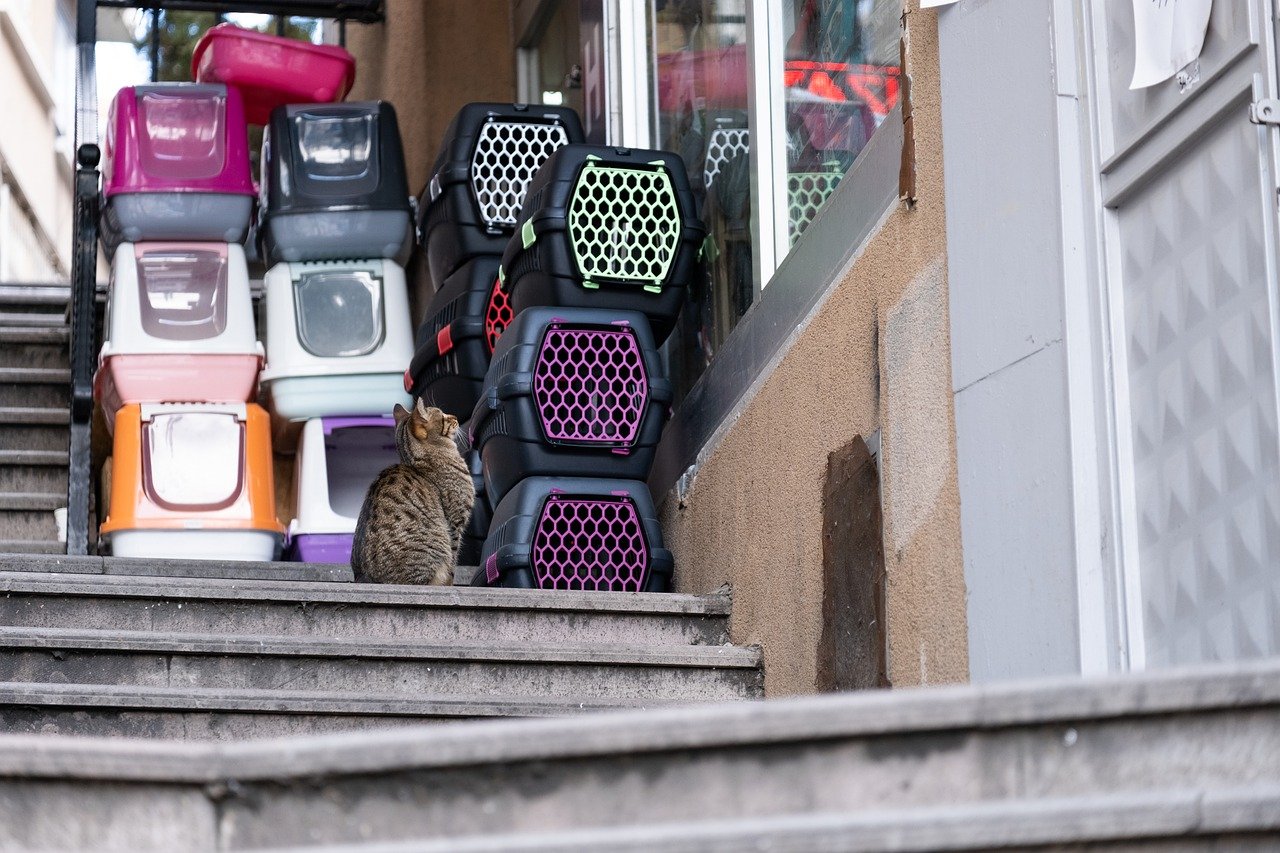
Responding to Your Pet's Body Language
Understanding your rescue pet's body language is just the first step in building a strong bond. The real magic happens when you respond appropriately to their signals. Think of it as a dance; you lead, but you must also follow their cues to create a harmonious relationship. When your pet shows signs of happiness, fear, or discomfort, knowing how to react can make all the difference in their adjustment to their new home.
For instance, if you notice your pet wagging their tail and bouncing around, it’s a clear sign they’re excited and happy to see you. In this case, you might respond with enthusiasm, perhaps by kneeling down to their level and offering gentle pets or words of encouragement. This helps reinforce their positive feelings and strengthens your bond. On the other hand, if your pet has a tucked tail and is cowering in a corner, it’s crucial to approach the situation with care. You wouldn’t want to overwhelm them further, so consider speaking softly and giving them space to come to you when they feel ready.
Here are some key points to keep in mind when responding to your pet's body language:
- Stay Calm: Your own body language can influence your pet. If you appear anxious or agitated, they may become more stressed.
- Use Positive Reinforcement: Reward your pet with treats or affection when they display positive behaviors. This encourages them to repeat those actions.
- Give Space: If your pet shows signs of fear, like hiding or backing away, respect their need for space. Allow them to approach you on their own terms.
- Observe and Adapt: Every pet is unique. Pay attention to their individual quirks and adjust your responses accordingly.
In addition to these points, it’s helpful to keep a mental note of your pet’s typical behaviors. For example, if your dog usually runs to the door when you come home, but suddenly starts hiding, it may indicate something is bothering them. Being attentive to these changes can help you address any issues before they escalate. Remember, your goal is to create a safe and loving environment where your pet feels understood.
Moreover, consider the environment. Sometimes, external factors like loud noises or unfamiliar visitors can influence your pet's behavior. If you notice your pet acting out of character, it might be worth examining their surroundings. Creating a quiet, safe space for them can help alleviate anxiety and encourage them to express themselves more freely.
Ultimately, responding to your pet’s body language is about fostering trust and communication. The more you understand their signals, the better you can cater to their needs. This not only enhances their emotional well-being but also enriches your relationship. So, the next time you interact with your furry friend, remember that every wag, twitch, and glance is a conversation waiting to happen.
Q: How can I tell if my pet is happy?
A: Look for signs like a wagging tail, relaxed body posture, and playful behavior. If they seek your attention and engage in activities, it's a good indication of happiness.
Q: What does it mean if my pet's ears are back?
A: Ears pulled back can indicate fear or submission. It’s essential to assess the overall body language to understand their feelings better.
Q: How should I react if my pet shows aggression?
A: If your pet displays aggressive behavior, it’s crucial to remain calm and avoid direct eye contact. Give them space and try to identify the trigger to address the issue safely.
Q: Can pets understand our body language?
A: Yes! Pets are incredibly perceptive and can pick up on human body language and tone. Being aware of your own signals can help improve communication with your pet.
Frequently Asked Questions
- How can I tell if my rescue pet is happy?
Look for signs like a wagging tail, relaxed body posture, and playful behavior. When your pet approaches you with a wagging tail and a relaxed stance, it’s usually a good indicator that they’re feeling happy and comfortable in their new environment.
- What does it mean if my pet's tail is tucked between their legs?
A tucked tail often signifies fear or submission. If you notice this behavior, it’s essential to create a calm environment for your pet. Offer them comfort and space, and avoid overwhelming them with loud noises or sudden movements.
- How important is tail wagging in understanding my pet's emotions?
Tail wagging is crucial, but context matters! A fast wagging tail might indicate excitement, while a slow wag could suggest uncertainty or hesitation. Pay attention to the situation to better interpret your pet’s feelings.
- What should I do if my pet shows signs of aggression?
If your pet displays aggressive behavior, such as growling or showing their teeth, it’s vital to give them space. Avoid confrontational situations and consult a professional trainer or behaviorist to help address these issues safely.
- How can I read my pet's facial expressions?
Facial expressions are key to understanding your pet’s emotions. Look at their eyes—are they wide open or squinty? A relaxed mouth and ears that are in a neutral position often indicate a calm pet. Learning these cues can help you respond appropriately.
- What are some common signs of stress in rescue pets?
Common signs of stress include excessive grooming, panting, pacing, or hiding. If you notice these behaviors, it’s essential to create a safe space for your pet and consider consulting a veterinarian for further advice.
- How can I build trust with my rescue pet?
Building trust takes time and patience. Start by creating a routine, using positive reinforcement, and respecting their space. Engage in gentle play and allow them to approach you at their own pace, fostering a sense of security.



